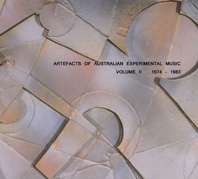 |
artefacts of australian experimental music volume II 1974-1983 |
Shame File Music SHAM056
www.shamefilemusic.com
Three years after the release of Volume I (which covered the years 1930-1973), Melbourne-based writer, artist and historian Clinton Green has produced a second compilation documenting Australian experimental musical activity. Covering the period from 1974 to 1983 it represents a vastly different economic, political, aesthetic and technological landscape from its predecessor: disillusionment with the 60s countercultural “revolution,” the fallout from the Whitlam dismissal, the emergent punk/post-punk nexus and the increasing availability of electronic equipment are all evident within these recordings. As such, it is a conduit into a not-so-distant past, albeit one that Ian Andrews, as quoted in the liner notes, described as “the lost decade.” Without any pretence of being exhaustive (let alone conclusive), the pieces and artists that Green has selected, along with his copious liner notes, are an attempt to rectify this situation; not only for students of the era, but for anyone interested in experimental arts practices in this country and in music in general.
There are a couple of factors that distinguish the music found on Volume II from the earlier compilation, one of which might be summed up in the phrase “less Cage, more collage.” Where previously adventurous composers had cleaved closely to the edicts of pre-eminent American composer John Cage, by the 1970s many of the precepts of “capital E” Experimental music—aleatoric processes, indeterminacy, extra-musical sounds and improvisation—had been well and truly internalised by artists and audiences alike. This allowed for their redeployment both within and across aesthetic schemes that intersected with a variety of agendas, be they musical, technological or social. Early works by The Loop Orchestra, Severed Heads and Ian Hartley combine tape loops and cut up procedures, appropriation and electronic sounds, encountering musique concrète, pop, field recording and radio along the way. Performers in Ron Nagorcka’s Atom Bomb use toy instruments and domestic tape recorders in a live performance that builds into a multi-layered, multi-directional sound. Minimalist repetition is combined with pop music’s own forms of reductionism by Essendon Airport and tch, tch, tch/tsk, tsk tsk (the symbol that is the correct nomenclature being unreproducible here) before being pounded to pieces with noisy “anti-musical” fervour by The Primitive Calculators.
Secondly—and this pertains mainly to pieces from the 1970s—the relationship between artists, infrastructure and institutions is at times quite marked. Tristram Cary’s Soft Walls and other pieces by Carl Vine and Ros Bandt are recordings from an era when synthesizers were expensive items, and access to them was largely through university music departments, which would doubtless act as gatekeeper when it came to their use. As such these works present a more “classic” approach to electronic composition. In stark contrast is the Forced Audience project of Gary Warner that produced tape collage and appropriation works while operating outside the institutional system, which explicitly challenged the formal relationship between artist, audience and content. Although electronically generated and manipulated sound is far more prevalent on this set than the earlier volume (with the vast majority of pieces here overtly utilising electronics beyond recording), the economics and politics of using those technologies is manifest here both in the music and the means by which it is produced: the “do-it-yourself” credo so often attributed to the punk movement has been a perennial in experimental arts.
Apart from those already mentioned, works from a wide array of significant performers and composers are featured, among them Jon Rose, Ernie Althoff, Ian Andrews, Warren Burt and renowned Mebourne guitarist Dave Brown (in the group Signals, with David Wadelton and Chris Knowles). However, it’s the inclusion of more obscure acts such as Justinstink (Justin Butler), Voigt/465 and Purple Vulture Shit, along with soundtracks by Arthur Cantrill, the location recordings of Les Gilbert and the whirly instruments of Sarah Hopkins, that not only make this a valuable release, but helps to broaden our understandings of what constitutes experimental music in Australia.
Peter Blamey
© Peter Blamey; for permission to reproduce apply to [email protected]








 back
back